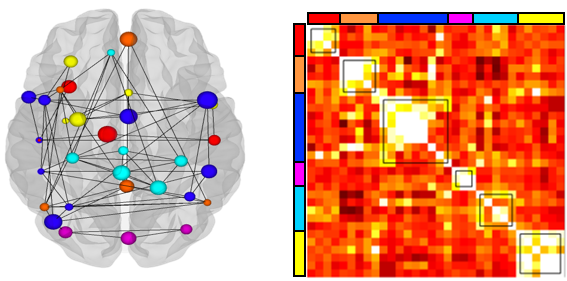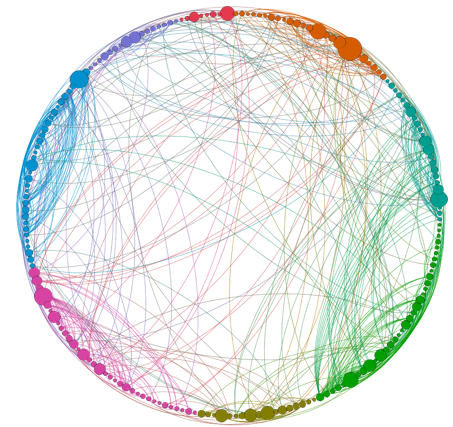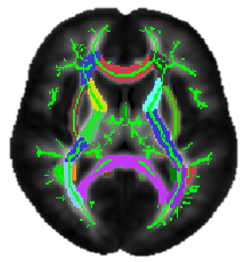 The NeuroCognitive Translation Lab aims to advance fundamental theory and engineer cutting-edge methods within cognitive neuroscience to better understand and predict mental abilities, as well as patient health outcomes. We accomplish these aims through the study of typical and abnormal biopsychological phenomena. Our lab applies behavioral, brain imaging (e.g., fMRI, DTI, fNIRS), and computational (e.g., machine learning, network analyses) techniques to answer two research questions: (1) What can our neural and behavioral signatures tell us about our mental abilities?, and (2) How can we best leverage these signatures for predicting human health outcomes?
The NeuroCognitive Translation Lab aims to advance fundamental theory and engineer cutting-edge methods within cognitive neuroscience to better understand and predict mental abilities, as well as patient health outcomes. We accomplish these aims through the study of typical and abnormal biopsychological phenomena. Our lab applies behavioral, brain imaging (e.g., fMRI, DTI, fNIRS), and computational (e.g., machine learning, network analyses) techniques to answer two research questions: (1) What can our neural and behavioral signatures tell us about our mental abilities?, and (2) How can we best leverage these signatures for predicting human health outcomes?
1. What can neural and behavioral signatures tell us about our mental abilities? This aspect of our research searches for fundamental features underlying human mental abilities. Our research has revealed basic mechanisms of interference-related forgetting in human memory (Hubbard et al., 2018 Memory), as well as the role of reward and executive systems in memory encoding (Hubbard et al., 2020 Journal of Cognitive Neuroscience; Shah et al., 2020 Cognitive Neuroscience). We have isolated cognitive deficits in clinical populations, in hope of aiding identification of neurocognitive dysfunction and precision treatment approaches in these groups (Hubbard et al., 2016 Cognition and Emotion; Journal of Affective Disorders). Moreover, we have revealed that disruptions in activity or communication with attention-related brain areas may lead to deficits in memory and other cognitive abilities in clinical groups (Hubbard et al., 2014, 2023 Clinical Psychological Science; Hubbard et al., 2016 Neuropsychology; Turner et al., 2019 NeuroImage).
underlying human mental abilities. Our research has revealed basic mechanisms of interference-related forgetting in human memory (Hubbard et al., 2018 Memory), as well as the role of reward and executive systems in memory encoding (Hubbard et al., 2020 Journal of Cognitive Neuroscience; Shah et al., 2020 Cognitive Neuroscience). We have isolated cognitive deficits in clinical populations, in hope of aiding identification of neurocognitive dysfunction and precision treatment approaches in these groups (Hubbard et al., 2016 Cognition and Emotion; Journal of Affective Disorders). Moreover, we have revealed that disruptions in activity or communication with attention-related brain areas may lead to deficits in memory and other cognitive abilities in clinical groups (Hubbard et al., 2014, 2023 Clinical Psychological Science; Hubbard et al., 2016 Neuropsychology; Turner et al., 2019 NeuroImage).

2. How can we best leverage these signatures for predicting human health outcomes? The immense burden faced by people struggling with psychiatric and neurological disorders implores research efforts directed at preventing and alleviating this burden. We apply neuroscience theory and methods to offer improved understanding, prediction, and, optimistically, guide precision treatment of clinical disorders. Here, we employ state-of-the-art neuroimaging and statistical modeling to discover “neuropredictors” of critical health outcomes (e.g., Auerbach et al., 2022 J Amer Acad Child and Adol Psychiatry). For instance, using novel fMRI approaches, we demonstrated that deficits in the ability to metabolize oxygen may serve as a prognostic marker in multiple sclerosis and offer a neurophysiological target for treatment (Hubbard et al., 2018 Human Brain Mapping; Brain Sciences). Our work within the Boston Adolescent Neuroimaging of Depression and Anxiety consortium, also employs cutting-edge brain imaging and clinical assessments to predict longitudinal changes in anxious and depressive symptomologies in adolescents (Hubbard et al., 2020 NeuroImage: Clinical; Hubbard et al., 2023 Clinical Psychological Science; Siless et al., 2020 NeuroImage: Clinical).